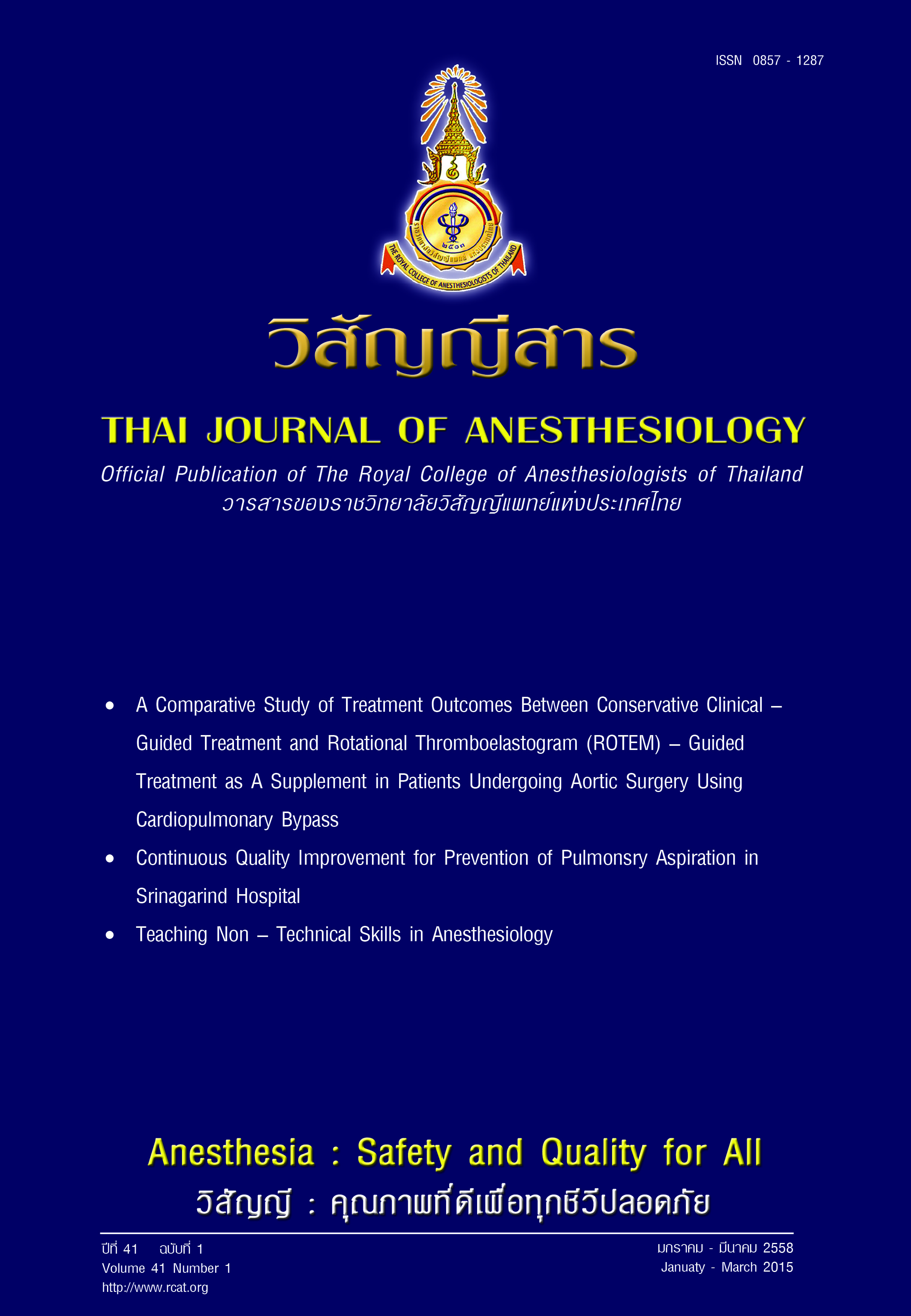A comparative study of treatment outcomes between conservative clinical - guided treatment and rotational thromboelastogram (ROTEM) - guided treatment as a supplement in patients undergoing aortic surgery using cardiopulmonary bypass
Main Article Content
Abstract
Background: Aortic surgery involves a large amount of blood loss and blood tranfusion. Evidently, coagulation abnormality plays an important part of blood loss. Rotational Thromboelastogram (ROTEM) is a coagulation monitor that has been proven effective to assist decision making for blood product transfusions.However, there is no evidence of such study in Thai population. The objective of this study was to demonstrate benefits of using ROTEM as a supplement guide for blood product transfusions in aortic surgery under cardiopulmonary bypass (CPB).
Method: Consecutive thirty-nine patients who were scheduled for aortic operations under CPB were recruited, and randomized into conservative clinical - guided treatment (CG = 21 patients) and supplemental ROTEM - guided treatment (RG = 18 patients). Guidelines for blood product transfusions were set. The main outcomes, which were blood loss, events of blood product transfusion, the time duration for stop bleeding, and reoperation were recorded and analyzed. T - test, Mann - Whitney U test or chi -square were applied for comparison as appropriate. A p - value < 0.05 indicated statistical significance.
Results: There was a significant higher number of pack red cell transfusions (PRC) in ICU of RG than that of CG (2.17 + 1.42 vs 1.24 + 2.24 units, p - value = 0.02); a significant higher number of patient who received PRC in ICU (18 vs 15 patients, p - value = 0.01). Regarding platelet transfusions, a significant higher number of platelet unit was used intra-operatively of CG (4.10 + 2.48 vs 2.11 + 2.78 units, p - value = 0.02); a higher number of patients who received platelet in ICU was also found (9 vs 4 patients, p - value = 0.03). Amount of blood loss, fresh frozen plasma (FFP) transfusion and the event of reoperation showed no significant differences between the two groups.
Conclusions: Intrinsic factors other than heparin - related factors are common causes of abnormal coagulation after CPB. FFP transfusion was absolutely indicated in the aortic surgery. ROTEM was not helpful for reducing the blood losses, the time duration of stop bleeding, the number of transfused FFP and the cryoprecipitate usage. The usefulness of ROTEM that could be demonstrated was reduction of the number of platelet transfusion intra - operatively. However, there were some evidences supported a delay of treatment and continuous abnormal coagulation found in ICU that caused by ROTEM.
การศึกษาเปรียบเทียบผลการรักษาระหว่าง การใช้อาการทางคลินิกร่วมกับการตรวจเลือดมาตรฐาน และการใช้ Thromboelastogram (ROTEM) ร่วม ในผู้ป่วยที่เข้ารับการผ่าตัดหลอดเลือดแดงใหญ่เอออร์ต้าที่ใช้เครื่องปอดและหัวใจเทียม
บทนำ: การผ่าตัดหลอดเลือดแดงเอออร์ต้ามักมีการเสียเลือดและการให้เลือดปริมาณมาก ซึ่งสาเหตุส่วนหนึ่งมาจากภาวะแข็งตัวของเลือดผิดปกติ มีการศึษาในต่างประเทศ พบว่า Rotational Thromboelastogram (ROTEM) เป็นเครื่องมือที่ช่วยวิเคราะห์สาเหตุของภาวะแข็งตัวของเลือดผิดปกติได้และช่วยในการตัดสินใจให้เลือดหรือสารประกอบเลือดได้อย่างมีประสิทธิภาพ แต่เนื่องจากยังไม่มีการศึกษาคนไทย การศึกษานี้จึงมีวัตถุประสงค์ จะศึกษาประโยชน์ของการนำROTEM มาใช้ช่วยตัดสินให้เลือดหรือสารประกอบเลือดในการผ่าตัดหลอดเลือดแดงเอออร์ต้าที่ใช้เครื่องปอดหัวใจเทียม
วิธีการศึกษา: ผู้ป่วยที่ยอมเข้าร่วมวิจัย 39 คน เป็นผู้ป่วยที่เข้ารับการผ่าตัดหลอดเลือดแดงเอออร์ต้าที่ใช้เครื่องปอดหัวใจเทียม ได้รับการสุ่มแบ่งเป็นสองกลุ่ม คือกลุ่มที่ใช้อาการทางคลินิกมาตรฐาน (CG = 21 คน) และกลุ่มที่ใช้ ROTEM ร่วมด้วย (RG = 18 คน) ในการตัดสินใจการให้เลือดหรือสารประกอบเลือด มีการจัดทำแนวทางกำกับการให้สารประกอบเลือดทั้งสองกลุ่ม ผลลัพธ์ที่ติดตามได้แก่ ปริมาณเลือดที่เสีย เหตุการณ์การให้เลือดหรือสารประกอบเลือด เวลาที่ใช้ในการหยุดเลือด และการเปิดผ่าตัดใหม่เพื่อหยุดเลือด ได้นำมาวิเคราะห์เปรียบเทียบระหว่างสองกลุ่มโดยใช้สถิติ t – test , Mann - Whitney U test หรือ chi - square นัยสำคัญทางสถิติถือที่ p - value < 0.05
ผลการศึกษา: พบจำนวนการให้ PRC ใน ICU ของกลุ่ม RG มากกว่าของกลุ่ม CG อย่างมีนัยสำคัญ (2.17 + 1.42 vs 1.24 + 2.24 ยูนิต, p - value = 0.02) จำนวนผู้ป่วยที่ได้รับให้ PRC ใน ICU ของกลุ่ม RG มากกว่ากลุ่ม CG อย่างมีนัยสำคัญ (18 vs 15 คน, p - value = 0.01) พบจำนวนเกล็ดเลือดที่ให้ในห้องผ่าตัดของกลุ่ม CG มากกว่ากลุ่ม RG อย่างมีนัยสำคัญ (4.10 + 2.48 vs 2.11 + 2.78 ยูนิต, p - value = 0.02) และพบจำนวนผู้ป่วยที่ได้รับเกล็ดเลือดใน ICU ของกลุ่ม CG มากกว่ากลุ่ม RG อย่างมีนัยสำคัญ (9 vs 4 คน, p - value = 0.03) แต่ปริมาณเลือดที่เสีย การให้ FFP และการเปิดผ่าตัดใหม่เพื่อหยุดเลือดไม่ต่างกันอย่างมีนัยสำคัญทางสถิติ
สรุป: ปัจจัยช่วยเลือดแข็งตัวภายในตัวอื่นๆ ที่ไม่ใช่เฮพารินเป็นสาเหตุที่สำคัญในการเกิดภาวะแข็งตัวของเลือดผิดปกติภายหลังหยุดเครื่องปอดหัวใจเทียม การให้ FFP มีความจำเป็นในการผ่าตัดหลอดเลือดแดงเอออร์ต้า การนำTEG มาใช้ร่วมกับการตัดสินใจตามอาการทางคลินิกมาตรฐาน ไม่ช่วยลดปริมาณเลือดที่เสีย เวลาที่ใช้ในการหยุดเลือด จำนวนการได้รับ FFP และ cryoprecipitate การนำ ROTEM มาใช้ สามารถช่วยลดการใช้เกล็ดเลือดในห้องผ่าตัด อย่างไรก็ตามพบว่า ROTEM อาจนำให้การรักษาล่าช้าเนื่องจากพบภาวะแข็งตัวของเลือดผิดปกติใน ICU


